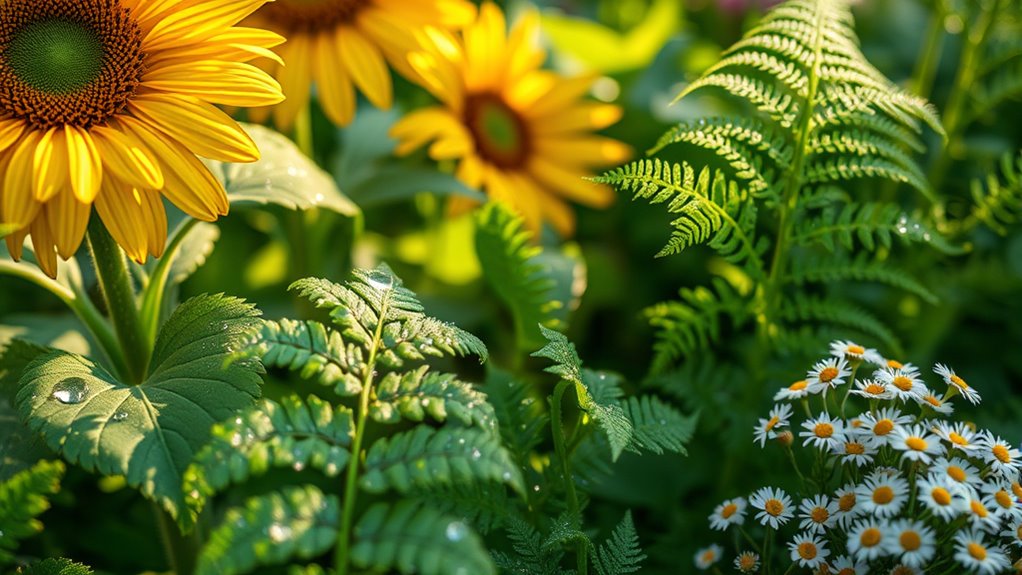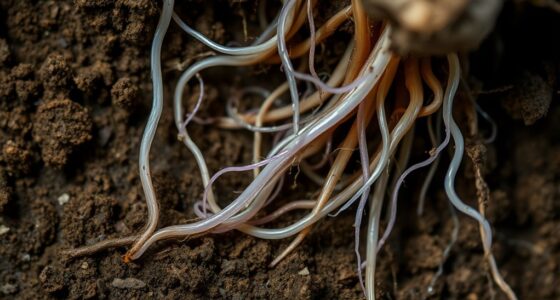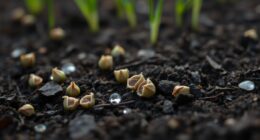Plants tell time using an internal biological clock made of genes and proteins, not a brain. This circadian system helps them coordinate daily activities like photosynthesis, opening stomata, and flowering. It reacts to environmental cues such as light and temperature and reset itself each day. This decentralized network spans tissues, allowing plants to anticipate changes and adapt efficiently. If you keep exploring, you’ll discover how this remarkable timing system keeps plants thriving without a brain.
Key Takeaways
- Plants use internal circadian clocks made of genes and proteins to generate 24-hour biological rhythms.
- Environmental cues like light and temperature reset and synchronize these internal clocks daily.
- Light receptors detect changes in ambient light, triggering molecular responses that adjust plant activities.
- The circadian system is decentralized, involving multiple cells and tissues, enabling rapid environmental responses.
- This internal timing mechanism allows plants to anticipate day-night cycles and optimize processes like photosynthesis and flowering.

Have you ever wondered how plants keep track of time? Even without a brain or nervous system, they manage an internal clock that aligns their activities with the day-night cycle. This remarkable ability hinges on their internal timekeeping mechanisms, which regulate processes like photosynthesis rhythms and circadian gene expression. These processes ensure plants optimize energy capture, growth, and survival by responding precisely to environmental cues. Through a complex interplay of molecular signals, plants can anticipate sunrise and sunset, adjusting their physiology accordingly. Moreover, the resilience of plants is partly due to their ability to adapt their circadian rhythms to changing environmental conditions, ensuring their survival across diverse habitats.
At the core of this timing system is the circadian clock, a set of genes and proteins that generate rhythmic patterns over a 24-hour period. Circadian gene expression is the process by which these genes turn on and off in a predictable cycle, governing many physiological functions. In plants, this includes the regulation of photosynthesis rhythms. As the sun rises, the clock prompts the plant to activate genes involved in photosynthesis, increasing the production of chlorophyll and other key components. When night falls, these activities diminish, conserving resources and preventing wasteful energy use. This synchronization ensures that the plant’s energy production peaks during daylight hours when sunlight is available, optimizing growth and resource use.
The circadian clock controls plant photosynthesis, optimizing energy use by synchronizing gene activity with day and night cycles.
The circadian clock relies on feedback loops involving specific genes and proteins that sense environmental signals like light and temperature. These signals influence circadian gene expression, effectively resetting the plant’s internal clock each day. Light receptors in plant cells detect changes in ambient light, triggering molecular responses that adjust circadian rhythms. This process allows plants to fine-tune their physiological responses, such as opening stomata for gas exchange or blooming at appropriate times, even before environmental conditions change markedly.
Unlike animals, plants don’t need a centralized brain to keep time. Instead, their circadian clock is distributed across various cells and tissues, working in a decentralized but coordinated manner. This system enables them to respond rapidly and efficiently to changes in their environment. By maintaining circadian rhythms and regulating photosynthesis rhythms, plants ensure that their biological activities are synchronized with the environment, helping them survive and thrive in a world that’s constantly changing.
In essence, plants tell time through an intricate network of genetic and molecular mechanisms. These systems allow them to predict environmental changes and optimize their functions accordingly. Without a brain, they achieve a level of temporal precision that’s truly astonishing, highlighting how life has evolved diverse strategies to adapt to the rhythm of nature.
Frequently Asked Questions
Can Plants Adjust Their Internal Clocks in Response to Climate Change?
Yes, plants can adjust their internal clocks through genetic adaptation and environmental cues. When climate change alters temperature, light, or seasonal patterns, plants respond by modifying their circadian rhythms, allowing them to optimize growth and survival. You might notice this in flowering times or leaf movements shifting in response to new conditions. These adjustments help plants stay synchronized with their environment, ensuring they thrive despite changing climate factors.
Do Different Plant Species Have Varying Circadian Rhythms?
Yes, different plant species exhibit varying circadian rhythms, showcasing species variation and rhythm diversity. You’ll notice that some plants open their flowers at dawn, while others do so at dusk, depending on their environmental adaptations. This diversity helps plants optimize photosynthesis, flowering, and other activities. By understanding these variations, you can better appreciate how plants have evolved unique internal clocks to thrive in diverse habitats worldwide.
How Do Plants Synchronize Their Clocks With the Earth’s Day-Night Cycle?
Your plants masterfully synchronize their clocks with Earth’s day-night cycle, like a perfectly tuned orchestra. They do this through photoreceptor signaling, which detects light changes, and circadian gene regulation, adjusting internal processes accordingly. When dawn breaks, light triggers signaling pathways, resetting their internal clocks. At night, darkness helps maintain the rhythm steady. This seamless adaptation ensures plants thrive, turning day and night signals into a biological symphony.
Are Plant Circadian Rhythms Affected by Artificial Light?
Artificial light definitely affects plant circadian rhythms and behavior. When you expose plants to artificial light, especially at night, it can disrupt their internal clock, causing changes in flowering, growth, and photosynthesis. Plants rely on natural light cues to synchronize their activities, so artificial light can confuse these signals. To keep your plants healthy, try to mimic natural light cycles and minimize exposure to artificial light during nighttime.
Can Plants’ Internal Clocks Influence Their Flowering Times?
Absolutely, your leafy friends can play mind games with you by timing their flowering perfectly. They use their internal clocks to optimize photosynthesis timing and hormone regulation, signaling when it’s prime time to bloom. This biological wizardry ensures they capitalize on daylight and pollinator activity, all sans a brain. So, next time a plant flowers unexpectedly, remember, it’s just a master of internal timing, not a tiny botanist plotting behind the scenes.
Conclusion
You might be surprised to learn that over 30,000 plant species rely on internal clocks to thrive without a brain. These biological timers help them optimize photosynthesis and growth by syncing with the day-night cycle. Just as you wake up with an alarm, plants “tell time” through genes and hormones, ensuring they’re always ready for sunrise or sunset. This incredible ability keeps them resilient and thriving, showing nature’s ingenious ways of adapting without a centralized brain.










